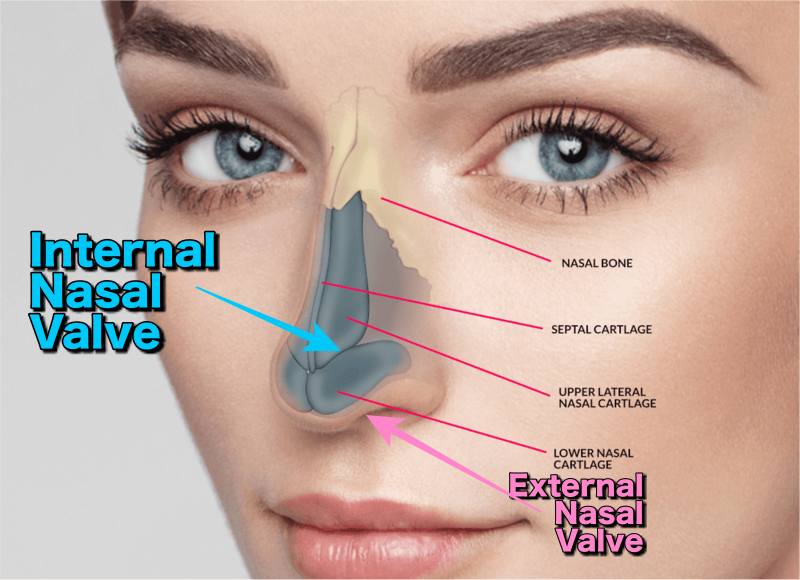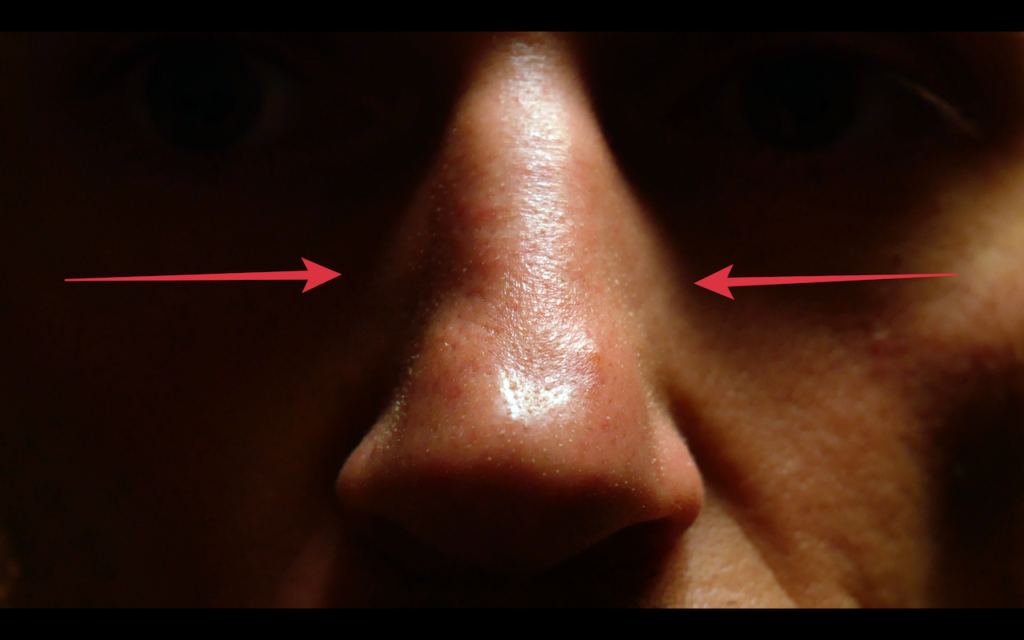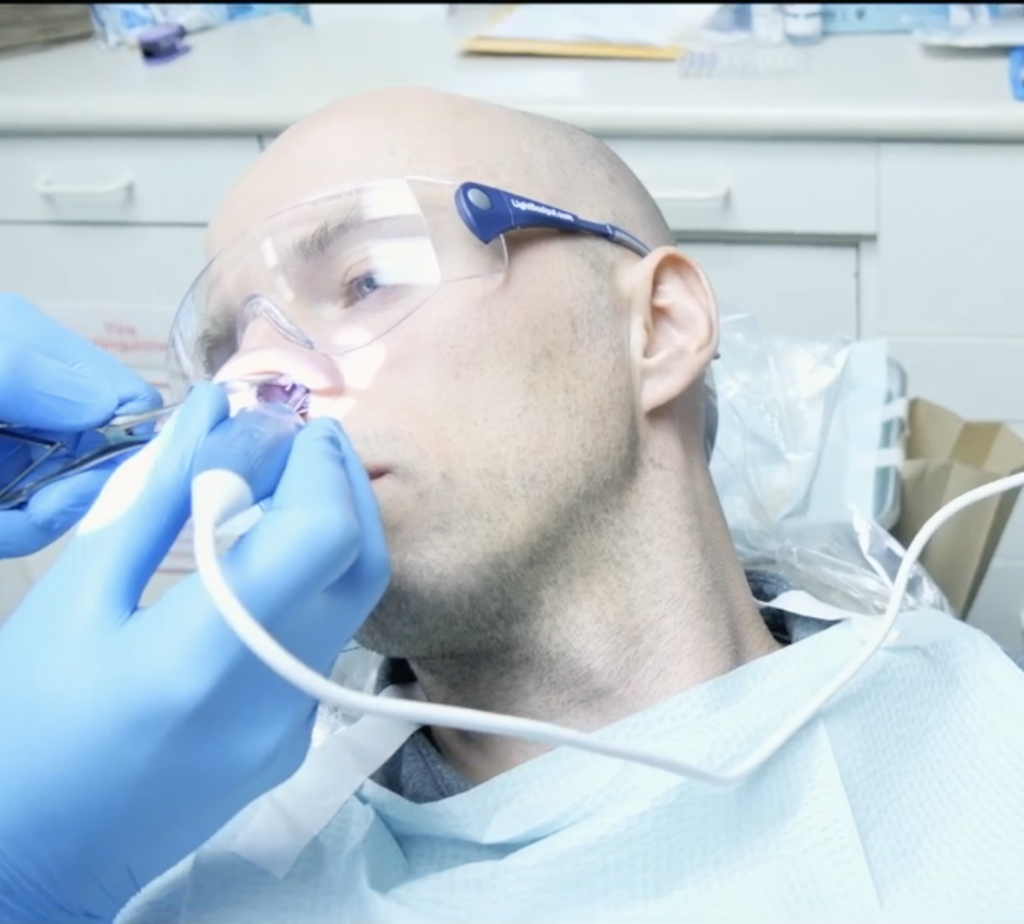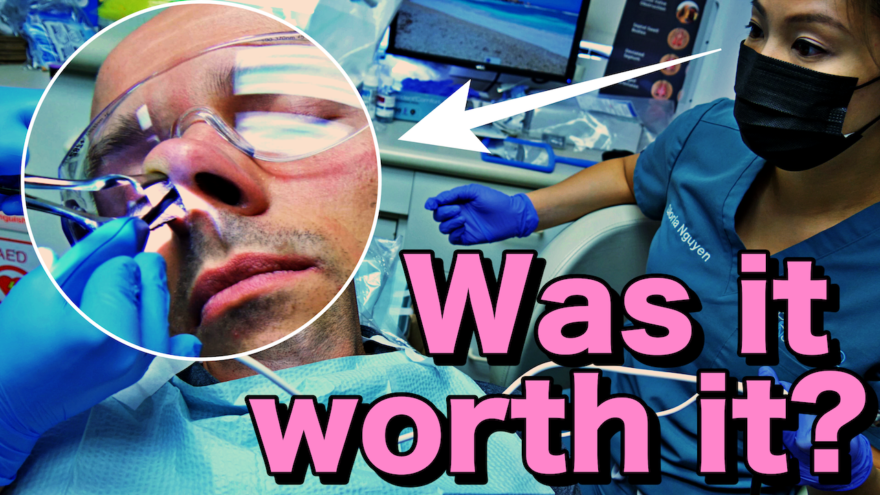Table of Contents
Is this surgery helpful for nasal valve dysfunction?
Nasal breathing has many positive health effects, but what if you are a chronic mouth breather? Perhaps you have nasal congestion that just won’t let up.
There can be many reasons for an inability to nasal breathe, one of them nasal valve dysfunction. If your nose collapses in when you breathe, as opposed to getting bigger, this could indicate an issue with the nasal valve.
Sadly, this can’t be improved with exercise. Instead, procedures are often used to improve nasal valve patency.
I just tried one of these procedures, called the Vivaer, at The Breathe Institute.
Does it work?
Watch the video and read the blog below to learn if it does.
Theory and research behind VivAer
There can be several causes of nasal obstruction:
- Deviated septum
- Turbinate hypertrophy
- Polyps
- Allergies
But one that is rarely discussed is nasal valve dysfunction. (Description taken from studies linked below)
Basically, your nose has two valves:
- The external nasal valve – The holes at the bottom of your nose
- The internal nasal valve – a valve that is just above the external one

Under normal circumstances, both of these nasal valves ought to expand as you breathe in.
But what happens when nasal valves go wrong?
The internal nasal valve is the narrowest part of the nose, which makes it the location where there is maximum airflow resistance.
Over time, the patency of this valve may weaken, which will cause it to collapse inward as you breathe in, rather than expand.

Now there are several treatments that may improve this valve’s function, most are fairly invasive.
The Vivaer is a bit less invasive. This procedure works by radiofrequency energy heating up the nasal airway tissue on the internal cartilage, which stimulates collagen contraction and tightening. Theoretically, this contractile alteration ought to allow the nasal valve to better expand as you breathe in.
In theory…
Does the evidence show VivAer works?
The studies on this procedure are few, and the objective measures performed are virtually nonexistent.
One subjective questionnaire that has a decent amount of validity and reliability is the NOSE scale. This scale measures nasal congestion, blockage, trouble breathing, sleeping, and not getting enough air during exercise. A 24 point change from an intervention is considered a clinically meaningful improvement (MCID).
Two of the initial studies were done by Jacobowitz et al 2019 and Ephrat et al 2021, the latter of which was a 2-year follow-up questionnaire from the former’s cohort.
These studies measured the NOSE at 6, 12, 18, and 24 months. Their results indicated a sustained improvement of 27.5-32.7 on the NOSE score over those dates, with a standard deviation that ranged from 22.5-31. There were only 3 nonresponders out of the 50 patient cohort.
These studies have three big problems:
- Nonrandomized, meaning you cannot rule out placebo effects
- The company that makes the VivAer device funded the projects
- The sample size of 50 is fairly small, with only 39 making it through the second study
Fortunately, Brehmer et al 2019 saves the day….sort of.
Here, 34 patients underwent the Vivaer, also measuring the NOSE score as well as a sleep study via the Watchpat200.
Although the sleep study was unchanged, there was a median improvement of 35 points on the NOSE score, with better results if severity was higher. 80% of patients had a positive outcome.
Sadly, this study also had some problems:
- Nonrandomized, meaning you cannot rule out placebo effects
- Even smaller sample size of 34
- Short follow-up of only 3 months
Although the study number is small and of lower quality, it was a worthwhile shot for me to take after weighing the risk/reward, especially after having such great success with the Mute Nasal Dilator (you can get one here).
Now let’s look at the procedure itself, being done on ya boi!
VivAer Procedure – the steps
The ViVaer procedure is really quick and relatively painless. In fact, most of the steps involve numbing agents to ensure there is minimal discomfort.
- Topical numbing agent
- Numbing strips that sit in the nose
- The shot (ouch, but only the initial prick hurt, there were several)
- More numbing strips
- The VivAer radio frequency ablation is done 3-5 rounds for about 30s. The temperature is about 60 celsius/140 farenheit.
- Topical ointment and nasal saline washes to be used frequently to promote tissue healing

Immediately after the procedure I felt AMAZING! Nasal breathing was definitely easier and less stressful with each progressive round of the VivAer.
Then the swelling set in.
2-weeks post-ViVaer Procedure
The first two weeks are by far the hardest part of the procedure. During this timeframe, your nose begins to swell (internally), the areas healing begin to crust over, and your nose is sore to move around (yeah, you’d be surprised how much your nose moves).
There were movements where I’d wake up gasping for air because I’d get so congested from all of the above. Fortunately, the ointment, saline rinses, and targeted nose picking (#hawt) reset everything. It wasn’t as great of a sensation as immediately after the procedure, but still pretty dang good.
When I had my online follow-up with Dr. Zaghi, he said all of these feelings were par for the course.
2-months post VivAer Procedure
Two months was the critical time period where all the initial healing stuff ought to have been done. I was no longer gasping for air and the crusting was significantly reduced.
Although my nasal breathing was better than pre-surgery, it wasn’t great. I had to nasal wash frequently in order to get nasal breathing to be pretty smooth. As in three times per day.
To help facilitate me nasal breathing better, Dr. Zaghi had me work on 3 things:
- Nasal exhale against resistance to change the pressure in my nose (this works pretty well)
- Use Boomsticks (these are essential oils that helped open up my nose)
- Use humidifiers more frequently (I Live in Las Vegas, the dry air can swell the turbinates)
All of the above strategies were quite helpful. If I don’t have access to a saline rinse, the exercise and Boomsticks could provide me temporary relief.
The humidifier at a higher humidity (50%ish) really helped things. I was no longer waking up from sleep in the morning breathing loudly.
5-months post ViVaer Procedure
It was at this time frame that I saw the most dramatic changes. Overall, my nasal breathing is significantly better.
I’ve noticed the following changes at this point in time:
- No congestion when I’m physically active…at all (Before I would get congested during hikes, have to spit a lot, and struggle nasal breathing)
- I no longer mouth breathe when working at the computer
- I breathe more quietly both when awake and asleep (per others)
- Neck tension when sitting is reduced
- My nostrils flare out when I inhale
It’s not all puppies and rainbows though big fam. The following things haven’t really changed all that much:
- I still have to nasal rinse frequently, though reduced (2-3 times per day)
- I still breathe somewhat loudly at times
- I will wake up nasal breathing loud at times
So the Vivaer was not a cure-all by any means. Fortunately, none of my symptoms were necessarily worse after the procedure.
Sum Up
That was my experience with the VivAer procedure. Although some of my symptoms remain, they have been reduced a fair amount, with many of my big complaints being resolved.
If I had to do it all over again, I would definitely get the procedure.
Should you get it done? Consult your ENT to see if it’s something worthwhile for treating dynamic nasal valve collapse.
To summarize:
- Nasal valve dysfunction is when the middle of the nose collapses in when you breathe
- Radiofrequency energy may help change the shape of the nasal cartilage to fix nasal collapse, though research is currently (2021) low quality
- I had improvements overall from the procedure, which was minimally painful. The hardest part was the first couple months.
References
– https://onlinelibrary.wiley.com/doi/full/10.1002/lio2.247
– https://www.ncbi.nlm.nih.gov/pmc/articles/PMC6426809/?utm_source=pocket_mylist
– https://onlinelibrary.wiley.com/doi/full/10.1002/alr.22667
Photo credits
– www.thebreatheinstitute.com
Song credits
And So It Begins by Artificial.Music | https://soundcloud.com/artificial-music/
Licensed under Creative Commons: Attribution 3.0 Unported (CC BY 3.0)
https://creativecommons.org/licenses/by/3.0/
Music promoted by https://www.chosic.com/free-music/all/
TRIPPIN COFFEE by Audionautix | https://audionautix.com/
Music promoted by https://www.chosic.com/free-music/all/
Creative Commons Attribution 4.0 International (CC BY 4.0)
https://creativecommons.org/licenses/by/4.0/
Music: https://www.chosic.com/free-music/all/
Latte by yoitrax | https://soundcloud.com/yoitrax
Music promoted by https://www.chosic.com/free-music/all/
Creative Commons Attribution 3.0 Unported License
https://creativecommons.org/licenses/by/3.0/deed.en_US
Green Tea by Purrple Cat | https://purrplecat.com/
Music promoted on https://www.chosic.com/free-music/all/
Creative Commons Attribution-ShareAlike 3.0 Unported (CC BY-SA 3.0)
https://creativecommons.org/licenses/by-sa/3.0/
Spring Showers by Purrple Cat | https://purrplecat.com/
Music promoted on https://www.chosic.com/free-music/all/
Creative Commons Attribution-ShareAlike 3.0 Unported (CC BY-SA 3.0)
https://creativecommons.org/licenses/by-sa/3.0/
Breathtaking by Purrple Cat | https://purrplecat.com/
Music promoted on https://www.chosic.com/free-music/all/
Creative Commons Attribution-ShareAlike 3.0 Unported (CC BY-SA 3.0)
https://creativecommons.org/licenses/by-sa/3.0/
Time to Think by Purrple Cat | https://purrplecat.com/
Music promoted on https://www.chosic.com/free-music/all/
Creative Commons Attribution-ShareAlike 3.0 Unported (CC BY-SA 3.0)

